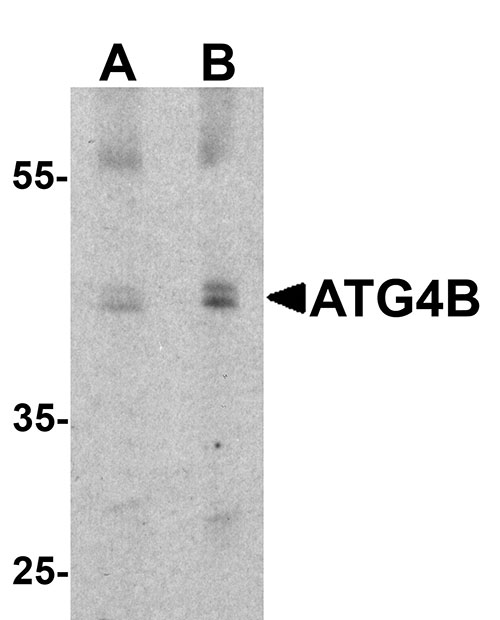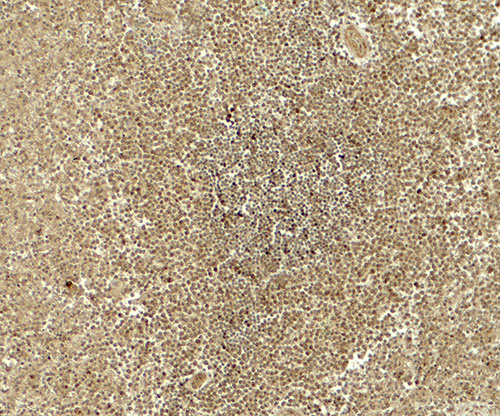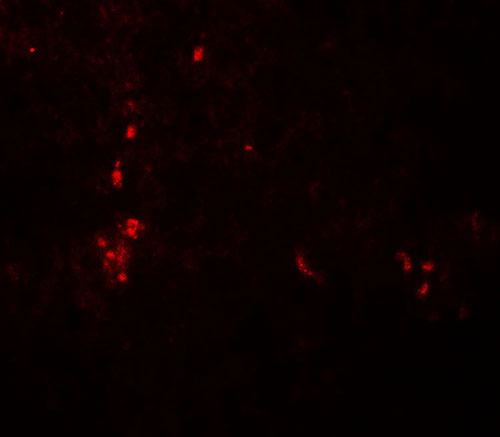ATG4B Antibody
- 产品详情
- 实验流程
- 背景知识
Application
| WB, IF, E, IHC-P |
|---|---|
| Primary Accession | Q9Y4P1 |
| Other Accession | NP_037457, 47132611 |
| Reactivity | Human, Mouse, Rat |
| Host | Rabbit |
| Clonality | Polyclonal |
| Isotype | IgG |
| Calculated MW | 44294 Da |
| Concentration (mg/ml) | 1 mg/mL |
| Conjugate | Unconjugated |
| Application Notes | ATG4B antibody can be used for detection of ATG4B by Western blot at 1 - 2 µg/ml. Antibody can also be used for immunohistochemistry starting at 5 µg/mL. For immunofluorescence start at 20 µg/mL. |
| Gene ID | 23192 |
|---|---|
| Other Names | Cysteine protease ATG4B, 3.4.22.-, AUT-like 1 cysteine endopeptidase, Autophagin-1, Autophagy-related cysteine endopeptidase 1, Autophagy-related protein 4 homolog B, hAPG4B, ATG4B, APG4B, AUTL1, KIAA0943 |
| Target/Specificity | ATG4B; ATG4B antibody is human, mouse and rat reactive. At least two isoforms of ATG4B are known to exist; this antibody will detect only the larger isoform. ATG4B is predicted to not cross-react with other ATG4 proteins. |
| Reconstitution & Storage | ATG4B antibody can be stored at 4℃ for three months and -20℃, stable for up to one year. |
| Precautions | ATG4B Antibody is for research use only and not for use in diagnostic or therapeutic procedures. |
| Name | ATG4B {ECO:0000303|PubMed:15187094, ECO:0000312|HGNC:HGNC:20790} |
|---|---|
| Function | Cysteine protease that plays a key role in autophagy by mediating both proteolytic activation and delipidation of ATG8 family proteins (PubMed:15169837, PubMed:15187094, PubMed:17347651, PubMed:19322194, PubMed:21177865, PubMed:22302004, PubMed:26378241, PubMed:27527864, PubMed:28633005, PubMed:28821708, PubMed:29232556, PubMed:30076329, PubMed:30443548, PubMed:30661429). Required for canonical autophagy (macroautophagy), non-canonical autophagy as well as for mitophagy (PubMed:33773106, PubMed:33909989). The protease activity is required for proteolytic activation of ATG8 family proteins: cleaves the C-terminal amino acid of ATG8 proteins MAP1LC3A, MAP1LC3B, MAP1LC3C, GABARAPL1, GABARAPL2 and GABARAP, to reveal a C- terminal glycine (PubMed:15169837, PubMed:15187094, PubMed:17347651, PubMed:19322194, PubMed:20818167, PubMed:21177865, PubMed:22302004, PubMed:27527864, PubMed:28287329, PubMed:28633005, PubMed:29458288, PubMed:30661429). Exposure of the glycine at the C-terminus is essential for ATG8 proteins conjugation to phosphatidylethanolamine (PE) and insertion to membranes, which is necessary for autophagy (PubMed:15169837, PubMed:15187094, PubMed:17347651, PubMed:19322194, PubMed:21177865, PubMed:22302004). Protease activity is also required to counteract formation of high-molecular weight conjugates of ATG8 proteins (ATG8ylation): acts as a deubiquitinating-like enzyme that removes ATG8 conjugated to other proteins, such as ATG3 (PubMed:31315929, PubMed:33773106). In addition to the protease activity, also mediates delipidation of ATG8 family proteins (PubMed:15187094, PubMed:19322194, PubMed:28633005, PubMed:29458288, PubMed:32686895, PubMed:33909989). Catalyzes delipidation of PE- conjugated forms of ATG8 proteins during macroautophagy (PubMed:15187094, PubMed:19322194, PubMed:29458288, PubMed:32686895, PubMed:33909989). Also involved in non-canonical autophagy, a parallel pathway involving conjugation of ATG8 proteins to single membranes at endolysosomal compartments, by catalyzing delipidation of ATG8 proteins conjugated to phosphatidylserine (PS) (PubMed:33909989). Compared to other members of the family (ATG4A, ATG4C or ATG4C), constitutes the major protein for proteolytic activation of ATG8 proteins, while it displays weaker delipidation activity than other ATG4 paralogs (PubMed:29458288, PubMed:30661429). Involved in phagophore growth during mitophagy independently of its protease activity and of ATG8 proteins: acts by regulating ATG9A trafficking to mitochondria and promoting phagophore-endoplasmic reticulum contacts during the lipid transfer phase of mitophagy (PubMed:33773106). |
| Cellular Location | Cytoplasm. Cytoplasm, cytosol. Cytoplasmic vesicle, autophagosome. Endoplasmic reticulum. Mitochondrion. Note=Mainly localizes to the cytoplasm, including cytosol (PubMed:29165041). A samll potion localizes to mitochondria; phosphorylation at Ser-34 promotes localization to mitochondria (PubMed:29165041). |
For Research Use Only. Not For Use In Diagnostic Procedures.
Provided below are standard protocols that you may find useful for product applications.
BACKGROUND
Autophagy, the process of bulk degradation of cellular proteins through an autophagosomic-lysosomal pathway is important for normal growth control and may be defective in tumor cells. It is involved in the preservation of cellular nutrients under starvation conditions as well as the normal turnover of cytosolic components (1,2). ATG4B, also known as AUTL1, is one of four mammalian orthologs of the yeast ATG4 protein; all four are cysteine proteases (3). ATG4 is required for ATG8 conjugation to phosphatidylethanolamine on autophagosomal membranes. In mammals, each ATG4 homolog shows a selective preference for the ATG8 homologs (4). ATG4B has been found to be a novel protective protein in inflammatory colitis (5).
REFERENCES
Gozuacik D and Kimchi A. Autophagy as a cell death and tumor suppressor mechanism. Oncogene 2004; 23:2891-906.
Kisen GO, Tessitore L, Costelli P, et al. Reduced autophagic activity in primary rat hepatocellular carcinoma and ascites hepatoma cells. Carcinogenesis 1993; 14:2501-5.
Marino G, Uria JA, Puente XS, et al. Human autophagins, a family of cysteine proteinases potentially implicated in cell degradation by autophagy. J. Biol. Chem. 2003; 278:3671-8.
Li M, Hou Y, Wang J, et al. Kinetic comparisons of mammalian Atg4 homologues indicate selective preferences towards diverse Atg8 substrates. J. Biol. Chem. 2011; 286:7327-38.
终于等到您。ABCEPTA(百远生物)抗体产品。
点击下方“我要评价 ”按钮提交您的反馈信息,您的反馈和评价是我们最宝贵的财富之一,
我们将在1-3个工作日内处理您的反馈信息。
如有疑问,联系:0512-88856768 tech-china@abcepta.com.























 癌症的基本特征包括细胞增殖、血管生成、迁移、凋亡逃避机制和细胞永生等。找到癌症发生过程中这些通路的关键标记物和对应的抗体用于检测至关重要。
癌症的基本特征包括细胞增殖、血管生成、迁移、凋亡逃避机制和细胞永生等。找到癌症发生过程中这些通路的关键标记物和对应的抗体用于检测至关重要。 为您推荐一个泛素化位点预测神器——泛素化分析工具,可以为您的蛋白的泛素化位点作出预测和评分。
为您推荐一个泛素化位点预测神器——泛素化分析工具,可以为您的蛋白的泛素化位点作出预测和评分。 细胞自噬受体图形绘图工具为你的蛋白的细胞受体结合位点作出预测和评分,识别结合到自噬通路中的蛋白是非常重要的,便于让我们理解自噬在正常生理、病理过程中的作用,如发育、细胞分化、神经退化性疾病、压力条件下、感染和癌症。
细胞自噬受体图形绘图工具为你的蛋白的细胞受体结合位点作出预测和评分,识别结合到自噬通路中的蛋白是非常重要的,便于让我们理解自噬在正常生理、病理过程中的作用,如发育、细胞分化、神经退化性疾病、压力条件下、感染和癌症。








